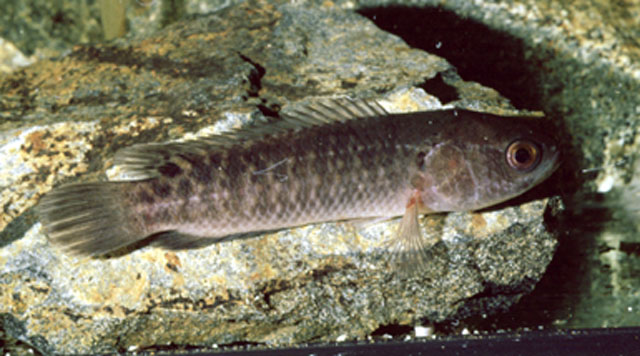| Anabantidae (Climbing gouramies) |
| 13.5 cm SL (male/unsexed) |
|
benthopelagic; freshwater; pH range: 6 - 7.5; dH range: 5 - 20 |
| Africa: Lufira River, Lualaba-Upemba, Luapula-Moero in Democratic Republic of the Congo, Upper Zambezi in Zambia and Angola and Cubango-Okovango-Ngami in Angola and Botswana (Ref. 6803). Also known from the Kunene (Ref. 120641), the Kafue and rivers of coastal Mozambique (Ref. 7248, 52193), the Cuanza (Ref. 7248, 52193, 120641) and the Kwango, Kwilu and Kasai systems (middle Congo River basin) in Angola (Ref. 11970). |
|
Dorsal spines (total): 16-19; Dorsal soft rays (total): 8-9; Anal spines: 8-9; Anal soft rays: 8-10. Description: Body elongated, eyes far forward, with a single median lateral line pore between them (Ref. 52193). Well-developed air-breathing organ in chamber above gills (Ref. 52193). Dorsal fin with 16-19 spines and 8-9 soft rays; anal fin with 8-9 spines and 8-10 soft rays (Ref. 52193). Scales ctenoid and coarse, 30-32 in lateral line; head completely scaled, edge of gill cover with undulating series of strong spines, cheek scales of mature males also develop visible spines along free edges (Ref. 52193). Colouration: Brown with irregular dark brown or black bars and spots (Ref. 52193). |
| Occurs in vegetated riverine backwaters, floodplain lagoons, swamps and isolated pans (Ref. 52193). It feeds on any suitably small creature, including insects, shrimps, and small fish; well camouflaged; hunts by slowly stalking prey (Ref. 52193). May congregate in groups to breed; the eggs are scattered around and not guarded (Ref. 52193). Can endure warm stagnant waters and is known to leave the water and move overland to alternative sites in wet weather or at night (Ref. 7248, 52193). |
|
Least Concern (LC); Date assessed: 30 April 2018 Ref. (130435)
|
| harmless |
Source and more info: www.fishbase.org. For personal, classroom, and other internal use only. Not for publication.

